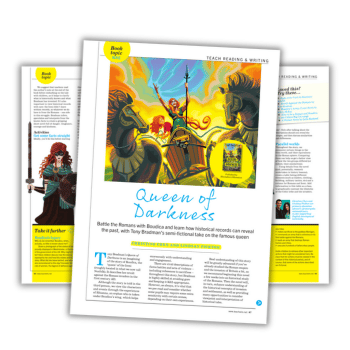This Boudicca KS2 planning resource shows you how to use the novel Queen of Darkness by Tony Bradman to enhance children’s understanding of the historical concepts of invasion and settlement. The book also provides many opportunities to consider viewpoint and interpretation of historical tales.
Bradman infers, speculates and interprets from the known facts. This allows him to create a gripping short novel full of danger, vengeance, courage and kindness.
What is Queen of Darkness about?
Tony Bradman’s Queen of Darkness is an imagining of the story of Boudicca. She was the ‘queen’ of the Iceni (roughly located in what we now call Norfolk). It describes her revolt against the Roman invaders in the first century AD.
Although Bradman tells the story in the third person, we view the characters and events through the experiences of Rhianna. She is an orphan whom Boudicca takes under her wing. This helps enormously with understanding and engagement.
There are vivid descriptions of fierce battles and acts of violence – including references to sacrifices – throughout this story. However, Bradman is highly skilled at avoiding gore and keeping this Boudicca KS2 story appropriate.
However, as always, it’s vital that we pre-read and consider whether some pupils may require some extra sensitivity with certain scenes, depending on their own experiences.
Enhancing understanding
You’ll greatly enhance pupils’ understanding of this story if you’ve already studied the Roman Empire and the invasion of Britain a bit. We recommend beginning this novel a few weeks into a historical study of the Romans.
Before embarking on the tale with children, read the author’s note at the end of the book. This helps to clarify what we know and what Bradman has invented.
It’s also important to view historical records with care. The Iceni didn’t leave written records, so whatever we do have is from the Romans – one side in this struggle.
Christine Chen and Lindsay Pickton are primary education advisors (primaryeducationadvisors.co.uk) supporting English development nationally. Browse more recommended KS2 books for topics.














